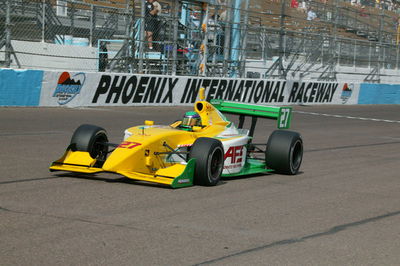Indy gets latest generation SAFER barriers.
Installation of the second generation of the revolutionary energy-absorbing SAFER Barrier is nearing completion at the Indianapolis Motor Speedway.
Speedway crews have replaced the original Steel and Foam Energy Reduction (SAFER) Barrier on the outside retaining wall of the Speedway oval's four turns with a "Version 2" of the barrier. The total length of the SAFER Barrier on the outside retaining wall is 5,056 feet.
The Version 2 SAFER Barrier features four major improvements:
Installation of the second generation of the revolutionary energy-absorbing SAFER Barrier is nearing completion at the Indianapolis Motor Speedway.
Speedway crews have replaced the original Steel and Foam Energy Reduction (SAFER) Barrier on the outside retaining wall of the Speedway oval's four turns with a "Version 2" of the barrier. The total length of the SAFER Barrier on the outside retaining wall is 5,056 feet.
The Version 2 SAFER Barrier features four major improvements:
The barrier sections, which were straight in Version 1, are slightly rolled, or curved, to provide a smoother impact surface.
A universal Styrofoam shape was created that is compatible with IndyCar Series cars and stock cars.
Improved attachment points anchor the barrier to the existing concrete retaining walls.
An increase of five steel tubes welded together form the barrier's exterior instead of four used in the Version 1 barrier.
The Speedway also permanently lengthened the SAFER Barrier by 200 feet from the entrance of turn 1, also turn 13 of the road course, northward into the main straightaway to add protection for drivers competing in the United States Grand Prix Formula One race.
Inside retaining walls exiting turns 2 and 4 each received 616 feet of the Version 1 SAFER Barrier that was removed from the outside walls. With the additional 1,232 feet on the inside walls, the total amount of concrete retaining wall at the Indianapolis Motor Speedway covered by the SAFER Barrier is 6,288 feet, or 1.19 miles.
Kevin Forbes, the Speedway's director of engineering and construction, said the original SAFER Barrier performed very well since its installation in May 2002, and Version 2 is the next step in its evolution.
Data collected from accidents at Indianapolis in 2002 involving both Indy Racing League IndyCar Series cars and NASCAR Nextel Cup Series stock cars allowed project engineers to find areas for improvement.
"Version 2 is a result of understanding exactly how Version 1 performed in the real world, being attached to the walls at the Indianapolis Motor Speedway versus the test facility in Nebraska," Forbes said. "There are things in the real world that occur when a car impacts a wall that we can't replicate in a laboratory. The lab gave us a model that we knew was going to be a vast improvement over bare concrete walls."
The most visible improvement is the addition of a fifth tube to the exterior of the barrier, adding strength to the area where the gearbox of a backward-sliding IndyCar Series strikes the barrier.
"(Added) strength means the entire assembly will move like it did before, but it won't gouge or gash the (steel tubing) like it did," Forbes said. "The primary goal there is to reduce repair time so the track can go green much more quickly after an accident."
Drivers sometimes encounter a secondary impact along the inside retaining wall, after making the harder initial contact with the SAFER Barrier lining the outside wall. So the Version 1 SAFER Barrier removed from the outside walls was installed along the inside wall to provide even more protection for drivers.
The SAFER Barrier first was installed on the four outside retaining walls of the Speedway's historic 2.5-mile oval in May 2002 after nearly four years of development by the Indianapolis Motor Speedway, Indy Racing League and University of Nebraska-Lincoln's Midwest Roadside Safety Facility. NASCAR joined in the development of the project in September 2000.
Since SAFER's debut in time for the 2002 Indianapolis 500, nearly every major oval racing facility in the United States has installed the system.











